Forays into Fantasy: The Compleat Enchanter by L. Sprague de Camp and Fletcher Pratt
Scott Lazerus is a Professor of Economics at Western State College in Gunnison, Colorado, and has been a science fiction fan since the 1970s. Recently, he began branching out into fantasy, and was surprised by the diversity of the genre. It’s not all wizards, elves, and dragons! Scott’s new blog series, Forays into Fantasy, is an SF fan’s exploration of the various threads of fantastic literature that have led to the wide variety of fantasy found today. FiF will examine some of the most interesting landmark books of the past, along with a few of today’s most acclaimed fantasies, building up an understanding of the connections between fantasy’s origins, its touchstones, and its many strands of influence.
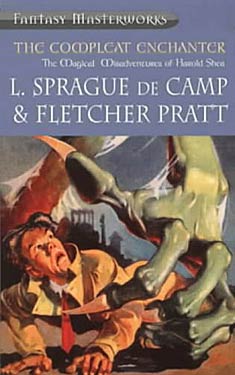 In 1939, L. Sprague de Camp, just embarking on a writing career, was introduced to Fletcher Pratt, who had published a number of stories in the science fiction pulps beginning in 1928, while working for Hugo Gernsback as a translator of European SF stories. De Camp became a regular at Pratt’s gatherings based around his elaborate naval war games. When John W. Campbell‘s Unknown fantasy magazine debuted in 1939, Pratt suggested a collaboration between the two authors–a series of novellas "about a hero who projects himself into the parallel worlds described in our world in myths and legends. We made our protagonist a brash, self-conceited young psychologist named Harold Shea," as de Camp explains in his 1975 essay "Fletcher and I."
In 1939, L. Sprague de Camp, just embarking on a writing career, was introduced to Fletcher Pratt, who had published a number of stories in the science fiction pulps beginning in 1928, while working for Hugo Gernsback as a translator of European SF stories. De Camp became a regular at Pratt’s gatherings based around his elaborate naval war games. When John W. Campbell‘s Unknown fantasy magazine debuted in 1939, Pratt suggested a collaboration between the two authors–a series of novellas "about a hero who projects himself into the parallel worlds described in our world in myths and legends. We made our protagonist a brash, self-conceited young psychologist named Harold Shea," as de Camp explains in his 1975 essay "Fletcher and I."
De Camp credits Pratt with the original idea behind the series, and considers him the "senior member" of the collaboration. They brainstormed the plots together, with Pratt providing most of the background for the stories’ mythological and literary settings. De Camp would take notes, and then write a rough draft, which Pratt would turn into a final draft. Lastly, de Camp would make the final edits prior to sending them to Campbell. The stories were a perfect fit for Unknown, where the first three novellas were published in 1940 and 1941. As John Clute and John Grant explain in The Encyclopedia of Fantasy, "Campbell sought to ensure the fantasy elements in Unknown obeyed some set of laws, in effect treating the supernatural as another science."
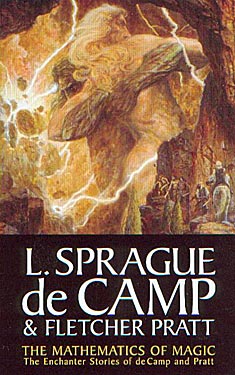 The title of the second novella, "The Mathematics of Magic" (1940), nicely encapsulates the rationalized approach to fantasy Campbell was looking for in the magazine. In each story, a mental technique developed by a group of psychologists is used to transport Shea and his companions to an alternate universe based on a national mythology or well-known literary setting. As lead psychologist Dr. Chalmers puts it, "the method consists of filling your mind with the fundamental assumptions of the world in question…. If one of these infinite other worlds–which up to now may be said to exist in a logical but not in an empirical sense–is governed by magic, you might expect to find a principle like that of dependence invalid, but principles of magic, such as the Law of Similarity, valid." Our world, in which cause and effect are linked by physical laws (dependence), is then replaced by a world where "effects resemble causes. It’s not valid for us, but primitive peoples firmly believe it. For instance, they think you can make it rain by pouring water on the ground with appropriate mumbo jumbo." By internalizing these magical laws, our heroes not only transport themselves to alternate worlds, but, once achieving a thorough enough understanding of the laws of these worlds, become practicing magicians there.
The title of the second novella, "The Mathematics of Magic" (1940), nicely encapsulates the rationalized approach to fantasy Campbell was looking for in the magazine. In each story, a mental technique developed by a group of psychologists is used to transport Shea and his companions to an alternate universe based on a national mythology or well-known literary setting. As lead psychologist Dr. Chalmers puts it, "the method consists of filling your mind with the fundamental assumptions of the world in question…. If one of these infinite other worlds–which up to now may be said to exist in a logical but not in an empirical sense–is governed by magic, you might expect to find a principle like that of dependence invalid, but principles of magic, such as the Law of Similarity, valid." Our world, in which cause and effect are linked by physical laws (dependence), is then replaced by a world where "effects resemble causes. It’s not valid for us, but primitive peoples firmly believe it. For instance, they think you can make it rain by pouring water on the ground with appropriate mumbo jumbo." By internalizing these magical laws, our heroes not only transport themselves to alternate worlds, but, once achieving a thorough enough understanding of the laws of these worlds, become practicing magicians there.
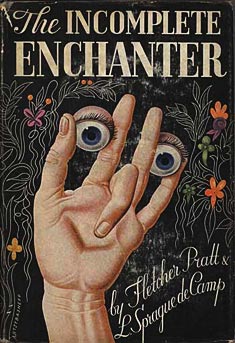 In the first novella, "The Roaring Trumpet" (1940), Shea, feeling vaguely dissatisfied with his humdrum life in Ohio and yearning for adventure, fires up the "syllogismobile" (his irreverent term for the logical formulations used for inter-universe transportation) for a trip to the world of Irish legend. But Shea has not grasped Dr. Chalmers concepts quite well enough to control the process precisely, and ends up in the wrong legend–that of Norse mythology. Shea is also unprepared for how to make use of magic in this world, but he gradually figures it out, becoming more proficient as he learns how the laws work. This partial understanding of the rules of the worlds he and his companions travel to means that the magic often doesn’t go quite right–the main source of the humor for which the series is known. In "The Mathematics of Magic", Shea and Chalmers, trying to conjure a dragon, get the qualitative aspect of the spell correct, but can’t nail down the quantitative. Instead of one dragon, they get 100; on the second attempt, they get .01 (a mini-dragon). They can’t figure out how to get the decimal point in the right place.
In the first novella, "The Roaring Trumpet" (1940), Shea, feeling vaguely dissatisfied with his humdrum life in Ohio and yearning for adventure, fires up the "syllogismobile" (his irreverent term for the logical formulations used for inter-universe transportation) for a trip to the world of Irish legend. But Shea has not grasped Dr. Chalmers concepts quite well enough to control the process precisely, and ends up in the wrong legend–that of Norse mythology. Shea is also unprepared for how to make use of magic in this world, but he gradually figures it out, becoming more proficient as he learns how the laws work. This partial understanding of the rules of the worlds he and his companions travel to means that the magic often doesn’t go quite right–the main source of the humor for which the series is known. In "The Mathematics of Magic", Shea and Chalmers, trying to conjure a dragon, get the qualitative aspect of the spell correct, but can’t nail down the quantitative. Instead of one dragon, they get 100; on the second attempt, they get .01 (a mini-dragon). They can’t figure out how to get the decimal point in the right place.
In another example, at the end of "The Roaring Trumpet," Shea comes up with a spell to get Heimdall and himself to Ragnarok on time by riding flying broomsticks, but the spell is not precise enough to include a reliable means of controlling their flight:
"Shea gripped the stick till his knuckles were white. Up – up – up he went, till everything was blotted out in the damp opaqueness of cloud. The broom rushed on at a steeper and steeper angle, till Shea found to his horror that it was rearing over backward. He wound his legs around the stick and clung, while the broom hung for a second suspended at the top of its loop with Shea dangling beneath. It dived, then fell over sidewise, spun this way and that, with its passenger flopping like a bell clapper."
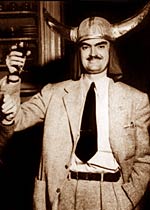 These misapplied spells, used for comedic effect, are a hallmark of the stories, and a source of the title of the book that combines the first two novellas, and by which the series itself has come to be known–The Incomplete Enchanter (1941). As for the plot, after becoming magically proficient and helping the Norse gods in the run-up to Ragnarok, Shea is sent home by a witch prior to the world-ending battle. Making better preparations this time, Shea and Chalmers, in "The Mathematics of Magic," travel to the world of Spenser’s The Faerie Queen (1596). While helping Queen Gloriana defeat a cabal of evil magicians (ending with a rather startling scene of magical massacre), Shea meets the huntress Belphebe, who will become his wife and travel with him back to Ohio at story’s end, while Chalmers stays behind, having fallen for a magical doppelganger of Lady Florimel, who he hopes to transform into a real woman once he masters enough magic.
These misapplied spells, used for comedic effect, are a hallmark of the stories, and a source of the title of the book that combines the first two novellas, and by which the series itself has come to be known–The Incomplete Enchanter (1941). As for the plot, after becoming magically proficient and helping the Norse gods in the run-up to Ragnarok, Shea is sent home by a witch prior to the world-ending battle. Making better preparations this time, Shea and Chalmers, in "The Mathematics of Magic," travel to the world of Spenser’s The Faerie Queen (1596). While helping Queen Gloriana defeat a cabal of evil magicians (ending with a rather startling scene of magical massacre), Shea meets the huntress Belphebe, who will become his wife and travel with him back to Ohio at story’s end, while Chalmers stays behind, having fallen for a magical doppelganger of Lady Florimel, who he hopes to transform into a real woman once he masters enough magic.
A third story, "The Castle of Iron," appeared in Unknown in 1941, and was later expanded into a novel published in 1950. The three stories would ultimately be collected in 1975 as The Compleat Enchanter. This time, Chalmers has transported himself from the world of The Faerie Queen to the world of its literary source–Ariosto’s Orlando Furioso (1532), based on legends of the conflict between Charlemagne’s knights and the Saracens attempting to invade Europe in the eighth century–hoping to get assistance from that world’s sorcerers in restoring Florimel to humanity. In another example of "incomplete enchantment," Chalmers, attempting to snatch Shea from Ohio in order to assist his magical studies, ends up with Belphebe instead. Now in Ariosto’s world instead of Spenser’s, Belphebe becomes Belphagor, the corresponding character in Orlando Furioso, with no memory of her previous adventures or her marriage to Shea. Confined to the eponymous castle by a powerful sorcerer, Shea and his companions must master the rules of Ariosto’s magical world in order to restore Belphebe and Florimel, while avoiding getting caught in the middle of the local conflict. Their misadventures involve, among other magical madness, infantile Paladins, a mistaken werewolf, a hippogriff and a magic carpet, culminating with a storming sorcerers’ battle.
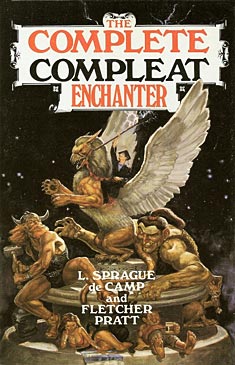 After expanding "The Castle of Iron", de Camp and Pratt went on to publish two more novellas–"The Wall of Serpents" in 1953 and "The Green Magician" in 1954. The full sequence of five eventually appeared as The Complete Compleat Enchanter. (The Fantasy Masterworks version of The Compleat Enchanter also contains all five stories. The NESFA Press collection titled The Mathematics of Magic also includes all the stories, with the addition of two more Shea stories written by de Camp in the early ‘90s.) In "The Wall of Serpents", Shea visits the world of Finnish mythology as described in the Kalevala, and finally makes it to Ireland in "The Green Magician", but the formula has become a little tiresome by that point.
After expanding "The Castle of Iron", de Camp and Pratt went on to publish two more novellas–"The Wall of Serpents" in 1953 and "The Green Magician" in 1954. The full sequence of five eventually appeared as The Complete Compleat Enchanter. (The Fantasy Masterworks version of The Compleat Enchanter also contains all five stories. The NESFA Press collection titled The Mathematics of Magic also includes all the stories, with the addition of two more Shea stories written by de Camp in the early ‘90s.) In "The Wall of Serpents", Shea visits the world of Finnish mythology as described in the Kalevala, and finally makes it to Ireland in "The Green Magician", but the formula has become a little tiresome by that point.
The basic idea is always the same–our heroes arrive in a new world where they must learn the rules of magic in order to help avert a catastrophe and find their way home. The strength of the stories is not in the plotting, but in the comedy and the excitement created by the incidents which tumble on one after another as the stories progress. The stories are also notable for their tone of near-intoxication induced in the characters and reader as a result of the pure exhilaration of their travels into the worlds of magic. (But, as with other sorts of intoxication, it can be overdone, and I was having a hard time continuing with the fourth and fifth novellas, as they began to seem repetitive. This is a series probably best experienced in smaller doses.) As in Silverlock, which also made use of Orlando Furioso as a major source (and whose author, John Myers Myers, was probably influenced by the Shea stories when writing his 1949 novel), immersion in the world of stories is a transformative and life-enhancing experience for characters who feel repressed by their mundane lives. By extension, this idea might be seen to represent the value of fantasy itself to its readers.
 Along with being a key exemplar of Unknown-style fantasy, the Incomplete Enchanter sequence also fits into a long tradition of humorous fantasy, stretching back to A Midsummer Night’s Dream and forward to Terry Pratchett. Pratt and de Camp certainly would have known the work of James Branch Cabell and Thorne Smith, published earlier in the century, which mixes mythology, fantasy, and social satire. In turn, de Camp and Pratt would influence the humorous fantasies of Piers Anthony, Robert Asprin, and many others. In the 1990s, Baen would publish two anthologies of new Harold Shea stories by modern authors influenced by the series.
Along with being a key exemplar of Unknown-style fantasy, the Incomplete Enchanter sequence also fits into a long tradition of humorous fantasy, stretching back to A Midsummer Night’s Dream and forward to Terry Pratchett. Pratt and de Camp certainly would have known the work of James Branch Cabell and Thorne Smith, published earlier in the century, which mixes mythology, fantasy, and social satire. In turn, de Camp and Pratt would influence the humorous fantasies of Piers Anthony, Robert Asprin, and many others. In the 1990s, Baen would publish two anthologies of new Harold Shea stories by modern authors influenced by the series.
A major aspect of the comedy in these stories, the inability to control magic, whether as a source of comedy or suspense, also has a long history. For example, consider Goethe’s The Sorcerer’s Apprentice (1798), which became the basis for the Mickey Mouse sequence in Disney’s Fantasia (coincidentally also released in 1940, the same year the Shea sequence began). Shea’s unending procession of dragons is reminiscent of the multiplying brooms and water pails in that story. And the idea that magical spells can be difficult to control, resulting in unintended consequences, became the starting point of nearly every plot in the hundreds of episodes of Bewitched and I Dream of Jeannie. Come to think of it, in this age of CGI, The Magical Misadventures of Harold Shea would probably work pretty well as a sitcom….
Forays into Fantasy: The Well of the Unicorn by Fletcher Pratt
Scott Lazerus is a Professor of Economics at Western State College in Gunnison, Colorado, and has been a science fiction fan since the 1970s. Recently, he began branching out into fantasy, and was surprised by the diversity of the genre. It’s not all wizards, elves, and dragons! Scott’s new blog series, Forays into Fantasy, is an SF fan’s exploration of the various threads of fantastic literature that have led to the wide variety of fantasy found today. FiF will examine some of the most interesting landmark books of the past, along with a few of today’s most acclaimed fantasies, building up an understanding of the connections between fantasy’s origins, its touchstones, and its many strands of influence.
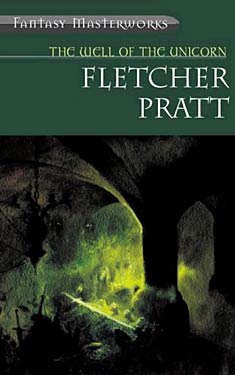 Fletcher Pratt, a military historian with a background in journalism and linguistics—he also worked as a translator—is best known to fantasy readers for his many collaborations with L. Sprague de Camp, especially the sequence of Harold Shea stories collected as The Incompleat Enchanter (1941). Earlier, he had published stories in Hugo Gernsback’s science fiction pulps as early as 1928. The Well of the Unicorn (1948) is one of two fantasy novels published by Pratt. The second, The Blue Star, came out in 1952, and neither was commercially successful, which may be why he abandoned the genre. According to James Cawthorn and Michael Moorcock, who include this novel in their Fantasy: The 100 Best Books, the publisher insisted that Pratt use a pseudonym (George U. Fletcher) to protect his reputation as a serious historical writer (although the de Camp collaborations had already been appearing under his own name), and the book flopped upon release, the publisher going out of business soon thereafter. Revived later as a paperback reprint, the book has gained in reputation since, lauded by Cawthorn and Moorcock along with David Pringle (it’s third chronologically in his Modern Fantasy: The Hundred Best Novels) and being reprinted in 2001 as part of the Fantasy Masterworks series.
Fletcher Pratt, a military historian with a background in journalism and linguistics—he also worked as a translator—is best known to fantasy readers for his many collaborations with L. Sprague de Camp, especially the sequence of Harold Shea stories collected as The Incompleat Enchanter (1941). Earlier, he had published stories in Hugo Gernsback’s science fiction pulps as early as 1928. The Well of the Unicorn (1948) is one of two fantasy novels published by Pratt. The second, The Blue Star, came out in 1952, and neither was commercially successful, which may be why he abandoned the genre. According to James Cawthorn and Michael Moorcock, who include this novel in their Fantasy: The 100 Best Books, the publisher insisted that Pratt use a pseudonym (George U. Fletcher) to protect his reputation as a serious historical writer (although the de Camp collaborations had already been appearing under his own name), and the book flopped upon release, the publisher going out of business soon thereafter. Revived later as a paperback reprint, the book has gained in reputation since, lauded by Cawthorn and Moorcock along with David Pringle (it’s third chronologically in his Modern Fantasy: The Hundred Best Novels) and being reprinted in 2001 as part of the Fantasy Masterworks series.
The plot will strike today’s readers as a fantasy standard: A young man—the protagonist Airar Alvarson—is unjustly removed from his family’s land by the Vulkings, who are consolidating their power and influence throughout the land of Dalarna, which is occupied by a number of different ethnic groups, including the Delacarles, Airar’s people, all of whom submit to an Empire which seems to be very decentralized (similar to the power of kings in early feudal Europe) and therefore not directly present to influence these events. Airar must set out into the world to find a living, but is soon waylaid by a talking owl, who leads him to the home of the wizard Meliboë, who offers Airar some gold to take a message to a band of conspirators (the “Iron Ring”) who are planning to fight back against the Vulkings’ depradations. Airar falls in with this group and, as the story progresses and the uprising grows, eventually becomes a military leader of the movement as he demonstrates his leadership abilities and tactical skill, a development foreseen by Meliboë. Along the way, he helps bring together various factions within Dalarna to resist the Vulkings—factions who normally would not be interested in cooperation, due to their differing social philosophies. As the story progresses, Airar matures into a leader, explores Dalarna with an eye to how its various societies work, and sets his heart on the Princess Argyra.
It sounds like a stock fantasy plot, but it must be kept in mind that this novel is prior to The Lord of the Rings, and the subsequent deluge of similar multi-volume quest/coming-of-age narratives. L. Sprague de Camp maintained that Pratt was influenced by Eddison’s The Worm Ouroboros, and Pratt himself points to Lord Dunsany as a precursor. Pratt borrows some of Dalarna’s history from Dunsany’s play “King Argimenes and the Unknown Warrior” though, as Pratt points out in his Author’s Note, “the events he cites took place generations before any told here, and he was only interested in a very small part of them.” The Well of the Unicorn, then, is a very early example of the “secondary world” fantasy—a fantasy set in a world that doesn’t exist, and to which (unlike, for example, Oz or Narnia), there is no access from our world. If modern readers find the premise familiar, it is because they have subsequently absorbed decades of this type of fantasy, though it would have seemed quite novel in 1948. (It would be interesting to know if Tolkien read Pratt’s fantasies.)
Though the plot (and to some degree the setting) will seem familiar to today’s fantasy readers, other aspects will come across as more unusual. The novel is quite long and complex, and is full of philosophical conflicts and discussions, to the point where it’s likely that modern fantasy fans might be impatient with the lack of action and forward movement, despite the fact that the story is based around a series of military campaigns. Airar, who has been “taxed out” of his land, along with many of his countrymen, by the Vulkings, becomes interested in why some societies are more successful than others. In particular, he explores the tradeoff between individual freedom and social order and discipline. The main contrast in his mind is between the Vulkings, who promote the most able individuals to positions of power, while enforcing rigid military discipline (ancient Rome could be the model), and the Carrhoene people of the Twelve Cities, who have a hereditary class-based system, in which individuals are raised to take on the positions they will ultimately hold in their society (as in feudal Europe). Airar’s own Delacarle people are more devoted to individual freedom and self-sufficiency (reminiscent of America in the colonial period), but lack the organization to resist the rule of the Vulkings. He also considers the freebooting “free city” of Os Erigu as a model. As Meliboë explains it to him:
For see—all’s well to be free and labor together (this is the thought forward on which you look, I take it); all’s well when it’s a matter of two or three to build a byre or hunt a bear, but when there are foemen in the land or something other where each man cannot see for himself what’s to be done, why then all must take the guidance of a man they never have seen nor perhaps heard on… So there’s your government permanent and paramount with authority atop and confidence below, and I know no ways of keeping it so but the ways of Briella [home city of the Vulkings] and Carhoenne. Ah, you’ll find tricks and devices, given names in the books—that is what books are for, to call names—but it comes to the same in the end… In either, those below are less than free.
Airar is not convinced. Instead, he develops the capacity to see the good and bad in the different societies (including those he considers enemies) in determining how to rule in a way that allows for authority when needed and freedom whenever possible. Since his own authority is derived from the respect from those who follow him, and his own respect for them, he seems on the way to doing his best to resolve a dilemma that can never entirely be solved.
 This is also a novel in which war is interrogated. Airar starts out young and inexperienced, with a romantic vision of war and a willingness to do whatever it takes to get revenge on the Vulkings. But on seeing a comrade speared through the throat in his first taste of conflict, “Airar went sick in the realization that war was no dainty sport as he had been taught, but horror and pain and the death of friends.” He cannot take joy in destruction, even of those whom he believes must be destroyed. But peace may also be a mirage, as represented by the titular Well of the Unicorn, a place of magical and religious significance controlled by the Empire. Those who partake of the Well are supposed to realize peace, but the four tales of the Well interspersed throughout the story (all told second-hand), seem to indicate that those who drink from it do not necessarily end up better off because of it.
This is also a novel in which war is interrogated. Airar starts out young and inexperienced, with a romantic vision of war and a willingness to do whatever it takes to get revenge on the Vulkings. But on seeing a comrade speared through the throat in his first taste of conflict, “Airar went sick in the realization that war was no dainty sport as he had been taught, but horror and pain and the death of friends.” He cannot take joy in destruction, even of those whom he believes must be destroyed. But peace may also be a mirage, as represented by the titular Well of the Unicorn, a place of magical and religious significance controlled by the Empire. Those who partake of the Well are supposed to realize peace, but the four tales of the Well interspersed throughout the story (all told second-hand), seem to indicate that those who drink from it do not necessarily end up better off because of it.
The role of magic in the novel is also unusual. As the Science Fiction Encyclopedia puts it, the world of the novel is “subtly irradiated” by magic. Its power is questionable, its results (as with the magical Well) may be unpredictable, and its use has consequences. Airar himself was trained by his father in magic, but the more he explores it, the less he desires to use it. It is physically draining, and Airar sees it as making him weak rather than strong. He would much prefer to show his capabilities as a man through real accomplishments, especially in battle, and by the end of the story shows no indication of using magic again. In fact, despite the existence of magic in the world of The Well of the Unicorn, it is very realistic for a fantasy novel. Dalarna could be Northern Europe during the early Middle Ages, the magic could be replaced by myth, and the story would be little altered. The battles depicted are based around realistic military tactics rather than magic. Magic in the story seems to be presented as something that the people of Darlarna might be better off without, representing a crutch by which some would avoid taking the real actions needed to deal with difficult situations. But this aspect, as with much else in the novel, is quite ambiguous.
While, as I have tried to indicate, there is much of interest in this novel, and its critical acclaim is understandable, it’s not surprising that it’s not better known and more popular. In a genre where exciting plot and intricate world building are prized, this is a novel in which the world is not especially original (it could be northern Europe in the early Middle Ages and nothing would need to change but the place names), and the plot bogs down for chapters at a time as the characters discuss strategy and debate philosophy. Pratt’s use of archaic-sounding language is also off-putting. Meliboë’s speech quoted above gives a sense of how the language style makes continuous use of odd sentence structures—objects placed before subjects, invented pronouns and contractions—making it very difficult to follow without maintaining strong concentration on the reading. Pratt, being a linguist, may have based this strange grammar on ancient or foreign language structures, but I don’t know this for certain. This helps to create an unusual sense of place and mood, but it becomes tiresome over the three-hundred-plus pages of the novel. The novelty quickly wears off, and it soon becomes an impediment to becoming immersed in the story.
The Well of the Unicorn, then, is an interesting chapter in the history of fantasy literature, and certainly has its rewards, but is not likely to appeal much to today’s readers of fantasy. It seems to resist the fantastic aspects, just as Airar resists the call of magic. It raises many questions, but leaves most unanswered. One possibility is that Fletcher Pratt was using a fantasy novel to call into question the appeal of fantasy itself to the human imagination.
Next time I’ll be looking at The House on the Borderland by William Hope Hodgson, a Fantasy Masterwork from 1908. It’s a precursor to the sort of "weird tale" that would be popularized later by H. P. Lovecraft and others. You’re all invited to read along!



















 Full Details
Full Details

